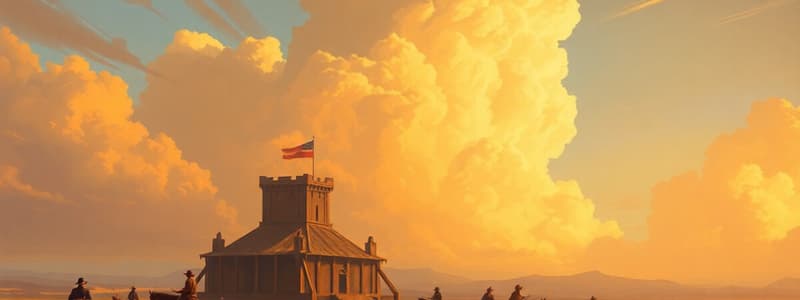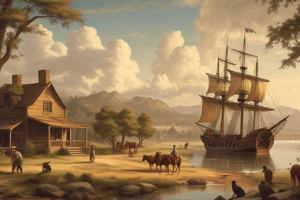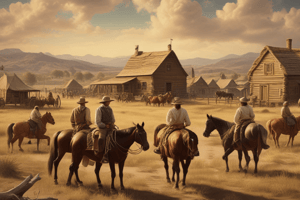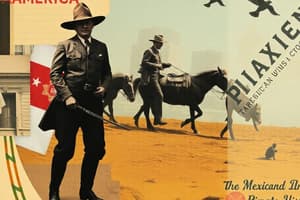Podcast
Questions and Answers
What was the main purpose of the Homestead Act of 1862?
What was the main purpose of the Homestead Act of 1862?
- To sell land to any citizen willing to cultivate it (correct)
- To provide land ownership to Native Americans
- To regulate the transportation of settlers
- To protect Native American lands from colonization
What effect did the Dawes Act of 1887 have on Native Americans?
What effect did the Dawes Act of 1887 have on Native Americans?
- It encouraged them to maintain their traditional hunting lifestyle
- It forcibly reduced their lands and aimed to turn them into farmers (correct)
- It granted them full citizenship rights
- It encouraged them to retain larger areas of land
Which event significantly increased the rate of migration to the West after 1849?
Which event significantly increased the rate of migration to the West after 1849?
- The Gold Rush in California (correct)
- The Homestead Act legislation
- The signing of the treaty of Guadalupe-Hidalgo
- The establishment of the Transcontinental Railroad
Who were the 'trail blazers' in the context of westward expansion?
Who were the 'trail blazers' in the context of westward expansion?
What strategy did elites use to maintain their power over marginalized groups?
What strategy did elites use to maintain their power over marginalized groups?
What was one of the primary challenges faced by settlers in the wilderness?
What was one of the primary challenges faced by settlers in the wilderness?
Who was primarily excluded from voting rights in the new nation?
Who was primarily excluded from voting rights in the new nation?
What role did buffalo soldiers play during westward expansion?
What role did buffalo soldiers play during westward expansion?
What did the notion of the land as a 'virgin female' imply?
What did the notion of the land as a 'virgin female' imply?
What significant impact did the increase in land ownership during expansion have?
What significant impact did the increase in land ownership during expansion have?
What was one outcome of the American Revolution regarding social inequality?
What was one outcome of the American Revolution regarding social inequality?
What was the primary mode of transportation for settlers during their westward journey?
What was the primary mode of transportation for settlers during their westward journey?
How did oppressed groups respond during the colonization period?
How did oppressed groups respond during the colonization period?
What did Turner's frontier thesis emphasize?
What did Turner's frontier thesis emphasize?
What was the purpose of creating a language of freedom and equality during the revolution?
What was the purpose of creating a language of freedom and equality during the revolution?
What role did fear of uprisings play among the elites?
What role did fear of uprisings play among the elites?
What perspective did Turner provide regarding the perception of Native Americans by settlers?
What perspective did Turner provide regarding the perception of Native Americans by settlers?
How does Kolodny relate the feminization of land to colonization?
How does Kolodny relate the feminization of land to colonization?
What was a common interpretation of the decimation of Native Americans due to epidemics by early colonists?
What was a common interpretation of the decimation of Native Americans due to epidemics by early colonists?
According to Thomas Jefferson's views in 1781, what were Native Americans expected to do?
According to Thomas Jefferson's views in 1781, what were Native Americans expected to do?
What metaphorical role did the land play according to the transforming views of colonizers?
What metaphorical role did the land play according to the transforming views of colonizers?
What was a significant aspect of the Puritan vision regarding Native Americans?
What was a significant aspect of the Puritan vision regarding Native Americans?
What was part of Jefferson's secret agenda regarding Native Americans?
What was part of Jefferson's secret agenda regarding Native Americans?
What did the settlers perceive as the only chance for Native Americans according to Jefferson?
What did the settlers perceive as the only chance for Native Americans according to Jefferson?
What was the minimum requirement for a homesteader to prove up their claim to free land?
What was the minimum requirement for a homesteader to prove up their claim to free land?
What was one major consequence of the Dawes Act for Native Americans?
What was one major consequence of the Dawes Act for Native Americans?
What was Thomas Jefferson's belief regarding the Native Americans and their way of life?
What was Thomas Jefferson's belief regarding the Native Americans and their way of life?
What was the primary philosophy promoted by John Collier during his tenure as Commissioner of Indian Affairs?
What was the primary philosophy promoted by John Collier during his tenure as Commissioner of Indian Affairs?
Which statement describes the original intention of the Dawes Act?
Which statement describes the original intention of the Dawes Act?
What ultimately happened to the lands that remained after the allotment under the Dawes Act?
What ultimately happened to the lands that remained after the allotment under the Dawes Act?
How did John Collier view the allotment policy regarding Native American lands?
How did John Collier view the allotment policy regarding Native American lands?
What type of policy is described by the actions taken under the Dawes Act towards Native Americans?
What type of policy is described by the actions taken under the Dawes Act towards Native Americans?
Which historical event initiated the formal establishment of slavery in the American colonies?
Which historical event initiated the formal establishment of slavery in the American colonies?
Which of the following describes an effect faced by Native Americans due to the lands being unsuitable for farming?
Which of the following describes an effect faced by Native Americans due to the lands being unsuitable for farming?
What perspective did early British travelers have about Africans according to Pliny's writings?
What perspective did early British travelers have about Africans according to Pliny's writings?
Which of the following best describes the relationship between the Dawes Act and Native American land rights?
Which of the following best describes the relationship between the Dawes Act and Native American land rights?
Which of the following associations is typically attributed to the color white in historical context?
Which of the following associations is typically attributed to the color white in historical context?
What biblical explanation was commonly cited for the differentiation of skin color, especially concerning blackness?
What biblical explanation was commonly cited for the differentiation of skin color, especially concerning blackness?
What role did Wovoka play in the context of Native American culture in the late 19th century?
What role did Wovoka play in the context of Native American culture in the late 19th century?
Which of the following statements about Jim Crow laws is accurate?
Which of the following statements about Jim Crow laws is accurate?
What were the effects of Spanish colonization on the indigenous population in North America?
What were the effects of Spanish colonization on the indigenous population in North America?
What role did the encomendero have in the encomienda system?
What role did the encomendero have in the encomienda system?
Which of the following statements best describes the transatlantic slave trade's initiation?
Which of the following statements best describes the transatlantic slave trade's initiation?
How were the lives of the encomendados typically affected under the encomienda system?
How were the lives of the encomendados typically affected under the encomienda system?
What was a consequence of the cultural loss due to Spanish colonization?
What was a consequence of the cultural loss due to Spanish colonization?
What was a key characteristic of indentured servitude during Spanish colonization?
What was a key characteristic of indentured servitude during Spanish colonization?
What introduced new biodiversity to the Americas during Spanish colonization?
What introduced new biodiversity to the Americas during Spanish colonization?
Which was NOT a goal of the Spanish missions established in the Americas?
Which was NOT a goal of the Spanish missions established in the Americas?
Flashcards
Who was Francisco Vázquez de Coronado?
Who was Francisco Vázquez de Coronado?
Spanish explorer who searched for the Seven Golden Cities of Cibola (present-day New Mexico) but failed to find them. He also explored the southwestern U.S., including Arizona, where he encountered the Grand Canyon.
What was one major effect of Spanish colonization on Native Americans?
What was one major effect of Spanish colonization on Native Americans?
Diseases introduced by Spanish colonists devastated Native American populations, significantly reducing their numbers.
How did Spanish colonization influence Native American culture?
How did Spanish colonization influence Native American culture?
The Spanish forced Native Americans to abandon their cultural practices and languages, leading to the loss of diverse traditions and customs.
How did religion play a role in Spanish colonization?
How did religion play a role in Spanish colonization?
Signup and view all the flashcards
What was the encomienda system?
What was the encomienda system?
Signup and view all the flashcards
What challenges did Native Americans face under the encomienda system?
What challenges did Native Americans face under the encomienda system?
Signup and view all the flashcards
How did the encomienda system contribute to the transatlantic slave trade?
How did the encomienda system contribute to the transatlantic slave trade?
Signup and view all the flashcards
What was indentured servitude?
What was indentured servitude?
Signup and view all the flashcards
Turner's Frontier Thesis
Turner's Frontier Thesis
Signup and view all the flashcards
Land as a 'Virgin Female'
Land as a 'Virgin Female'
Signup and view all the flashcards
Divide and Conquer
Divide and Conquer
Signup and view all the flashcards
Creating a Common Enemy
Creating a Common Enemy
Signup and view all the flashcards
Challenge of Unifying the Oppressed
Challenge of Unifying the Oppressed
Signup and view all the flashcards
Westward Expansion
Westward Expansion
Signup and view all the flashcards
Western Expansion
Western Expansion
Signup and view all the flashcards
Western Land Legislation
Western Land Legislation
Signup and view all the flashcards
Homestead Act (1862)
Homestead Act (1862)
Signup and view all the flashcards
Dawes Act (1887)
Dawes Act (1887)
Signup and view all the flashcards
Buffalo Soldiers
Buffalo Soldiers
Signup and view all the flashcards
Trailblazers
Trailblazers
Signup and view all the flashcards
Wagon Train
Wagon Train
Signup and view all the flashcards
Log Cabins
Log Cabins
Signup and view all the flashcards
Unsuitable land for farming under the Dawes Act
Unsuitable land for farming under the Dawes Act
Signup and view all the flashcards
Loss of tribal sovereignty
Loss of tribal sovereignty
Signup and view all the flashcards
Consequences of the Dawes Act
Consequences of the Dawes Act
Signup and view all the flashcards
Internal colonization
Internal colonization
Signup and view all the flashcards
Jefferson's view on Native Americans
Jefferson's view on Native Americans
Signup and view all the flashcards
Impact of the Dawes Act on Native American culture
Impact of the Dawes Act on Native American culture
Signup and view all the flashcards
The Dawes Act: A flawed policy
The Dawes Act: A flawed policy
Signup and view all the flashcards
How is land often depicted in colonization narratives?
How is land often depicted in colonization narratives?
Signup and view all the flashcards
How did colonists view the land before settling?
How did colonists view the land before settling?
Signup and view all the flashcards
Why were Native Americans considered an obstacle to expansion?
Why were Native Americans considered an obstacle to expansion?
Signup and view all the flashcards
How did the Puritans interpret Native American epidemics?
How did the Puritans interpret Native American epidemics?
Signup and view all the flashcards
What was the proposed solution for Native Americans to survive?
What was the proposed solution for Native Americans to survive?
Signup and view all the flashcards
What was Jefferson's secret agenda regarding Native Americans?
What was Jefferson's secret agenda regarding Native Americans?
Signup and view all the flashcards
What was the consequence of Native Americans resisting assimilation?
What was the consequence of Native Americans resisting assimilation?
Signup and view all the flashcards
How were Native American cultures perceived?
How were Native American cultures perceived?
Signup and view all the flashcards
What was the prevailing belief about Native American capabilities in the early 20th century?
What was the prevailing belief about Native American capabilities in the early 20th century?
Signup and view all the flashcards
What was John Collier's stance on Native American assimilation?
What was John Collier's stance on Native American assimilation?
Signup and view all the flashcards
What was the purpose of the Indian New Deal?
What was the purpose of the Indian New Deal?
Signup and view all the flashcards
Why did Collier criticize the allotment policy?
Why did Collier criticize the allotment policy?
Signup and view all the flashcards
What was the objective of the allotment policy?
What was the objective of the allotment policy?
Signup and view all the flashcards
What negative stereotypes were associated with African people in Europe?
What negative stereotypes were associated with African people in Europe?
Signup and view all the flashcards
What were the racial implications of the connotations of white and black?
What were the racial implications of the connotations of white and black?
Signup and view all the flashcards
How did early European accounts shape their understanding of Africa?
How did early European accounts shape their understanding of Africa?
Signup and view all the flashcards
Study Notes
Cultural Studies: United States of America
- The US is the 3rd largest country globally, half the size of Russia, one-third the size of Africa, and one and a half times the size of Western Europe.
- Pittsburgh, Pennsylvania is known for steel and coal.
- Massachusetts is home to some of the oldest universities (e.g., Harvard, Yale, Columbia).
- New York City is the most populous city, a multicultural hub due to immigration, and the financial center.
- Boston was initially inhabited by the Massachusett tribe and was later founded by Puritans seeking religious freedom.
- Boston flourished due to fishing and initially acted as a port for the cotton trade and migration.
- Philadelphia, Pennsylvania, was inhabited by the Lenape people before colonization.
- It was founded by William Penn, and its name means "city of brotherly love."
- Philadelphia is significant as the birthplace of the Declaration of Independence (1776) and the US Constitution (1787).
- The Mason-Dixon Line separates Maryland and Pennsylvania, established in 1763-1767 during disputes between the two states.
- Washington D.C. is a federal district, created to be the US capital, with buildings like the White House and the Capitol, housing the legislative branch.
- The Southeastern US features wetlands, rivers (e.g., Mississippi), and fertile land for agriculture, including cotton and tobacco.
- This area had a significant role in industrialization and tourism.
- Charleston, South Carolina, played a major role in the American Civil War and was a significant trading city.
- New Orleans, Louisiana, was originally a French settlement and was later ceded to Spain and Britain before becoming part of the USA.
- It's a major port and a center of jazz music.
- The western US features the Rocky Mountains, lakes, forests, and agriculture, ranging from the rainforests of California to the mountains and parks of Alaska.
- The American West is also a significant business center (Silicon Valley) and a major fishing market.
- Los Angeles, California, is renowned for the film industry and its population diversity.
- The Missouri River and the Mississippi River are significant rivers in the US.
- The US has several regions with various climates, including coastal plains, deserts (Mojave, Sonoran, Chihuahuan), and tropical climates (Hawaii).
- Columbus's voyages motivated European exploration and colonization.
- Christopher Columbus, Vasco da Gama, and Bartolomeu Dias were key figures.
- Columbus's four voyages aimed at finding a sea route to the Far East for trade, gold, and Christianity.
- The encounter with the "other" presents the need to choose assimilation or hierarchy.
- There are several views of the encounter in literature, such as in Shakespeare's The Tempest.
- Some notable explorers and colonizers were Hernando de Soto and Francisco Vázquez de Coronado.
- The effects of Spanish colonization included disease introduction, cultural loss, and biodiversity exchange and also religious conversion.
- The encomienda system was a system that involved assigning groups of Native Americans to Spanish settlers
- Settlers and colonists also brought over new technology in terms of farming in the US and also animals including horses and pigs.
- Indigenous peoples' land rights were taken away and there was conflicts with them.
- The Jamestown colony was founded in 1607 by English settlers, and tobacco emerged as a crucial crop in this colony.
- The Pilgrims (Separatists) aboard the Mayflower in 1620 settled in Plymouth, Massachusetts, and formed the Plymouth Colony.
- The Massachusetts Bay Colony followed.
- These colonists faced various hardships such as disease and starvation, yet they persisted and ultimately established the colonies.
- The Massachusetts Bay Colony became one of the largest settlements, impacting the development of the US.
- The American Revolution featured different groups, including colonists that sought independence from British rule (Patriots), and those (loyalists) who remained loyal to Great Britain's rule.
- Following the conflicts of the Boston Massacre, Boston Tea Party and the Intolerable Acts, the colonists fought for independence from the British monarchy.
- The key turning points and events included the Battles of Lexington and Concord (1775) and the Battle of Saratoga (1777).
- The US also participated in the Seven Years' War.
- The Stamp Act (1765), Sugar Act (1764) and The Tea Act (1773) are examples of taxes that were imposed by the British government against colonies which caused conflicts.
- The Treaty of Paris (1783) recognized the US's independence, including ceded territories from Britain.
- The nation was unified under a new constitution in 1787, but disputes between federalists and anti-federalists emerged.
- The American frontier expansion involved both violence and new settlement and new communities.
- Westward expansion was influenced by the belief in Manifest Destiny.
- Manifest Destiny is the idea that the US was destined to expand westward.
- The Homestead Act (1862) encouraged settlement of western lands by offering 160 acres of land to settlers (citizens who were at least 21 years old) in exchange for five years of occupation and improvements.
- The Dawes Act (1887) aimed to assimilate Native Americans and assigned land to individual Indians but did so causing problems because the plots of lands were often too small for farming purposes.
- Slavery was a significant social and political issue in the US.
- Resistance to slavery took on many different forms, culminating in the American Civil War (1861-1865).
- The Emancipation Proclamation (1863) declared that enslaved people in Confederate states were free.
- The 13th, 14th, and 15th Amendments to the Constitution abolished slavery, guaranteed citizenship and voting rights to former enslaved people.
- Reconstruction followed the war; yet, it did not achieve full racial equality for African Americans, and Jim Crow laws emerged.
- The 1920s (The Roaring Twenties) saw economic prosperity and social change.
- Women earned suffrage in 1920.
- The culture of the 1920s embraced the flapper look for women and flappers were involved in the consumption of alcohol..
- The 1920s also saw the rise of the automobile industry and its influence on culture and society.
- The Stock Market Crash of 1929 triggered the Great Depression, which significantly impacted the nation's economy and society.
- The New Deal (1933–1937), a series of programs implemented by President Franklin D. Roosevelt, was designed to address the economic crisis.
Studying That Suits You
Use AI to generate personalized quizzes and flashcards to suit your learning preferences.




